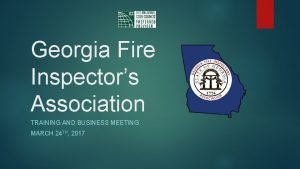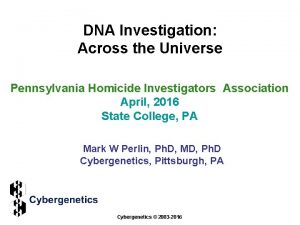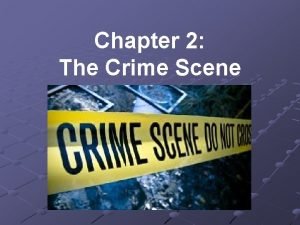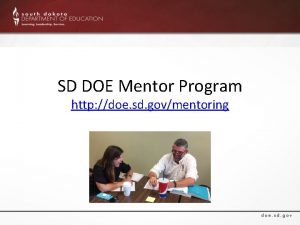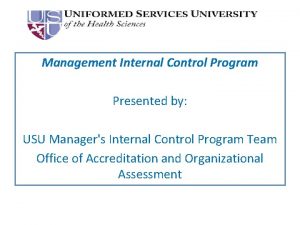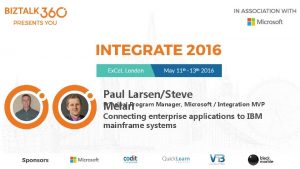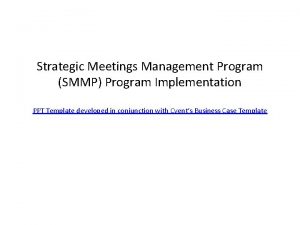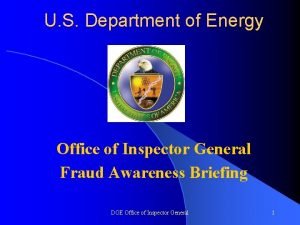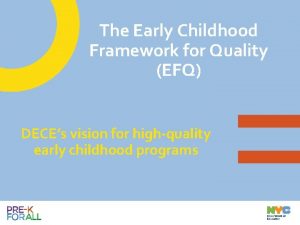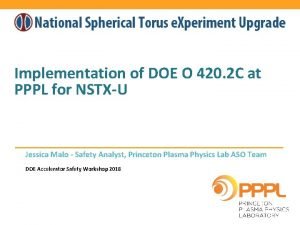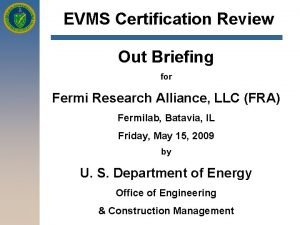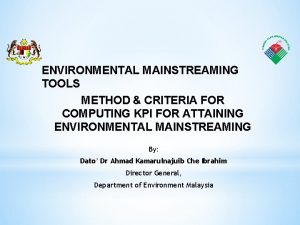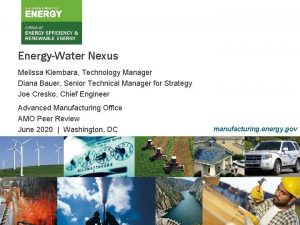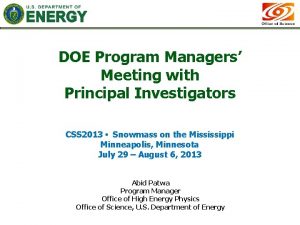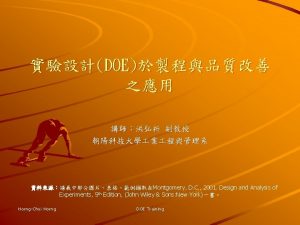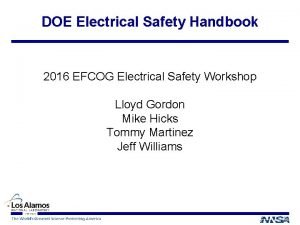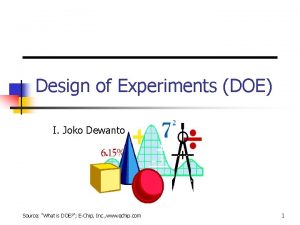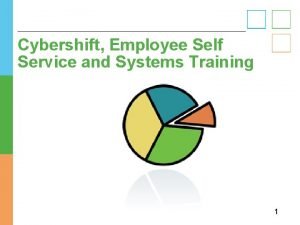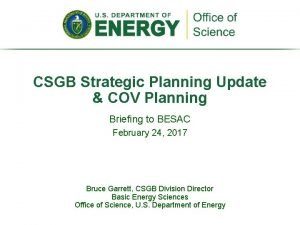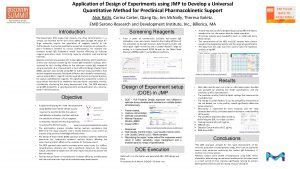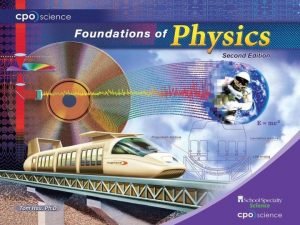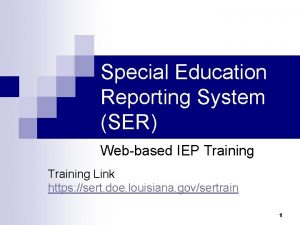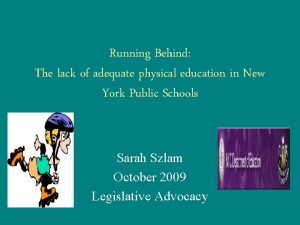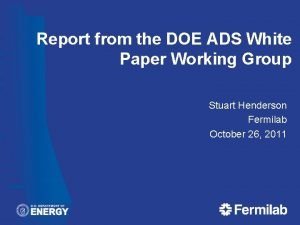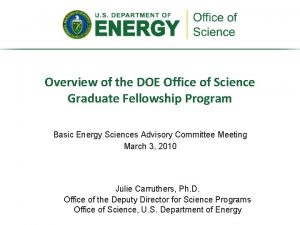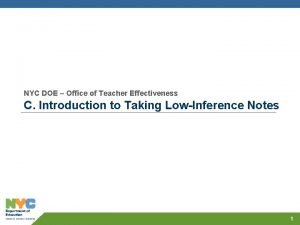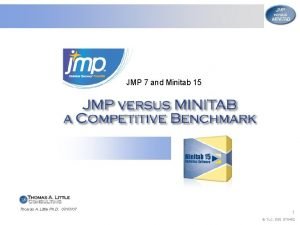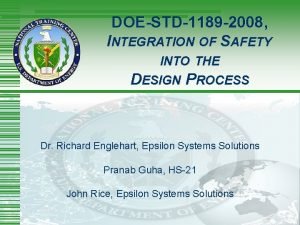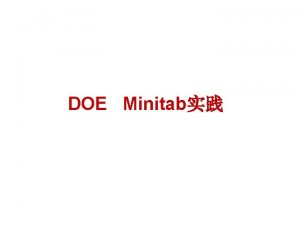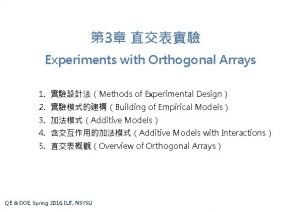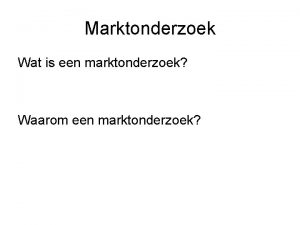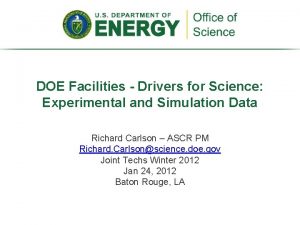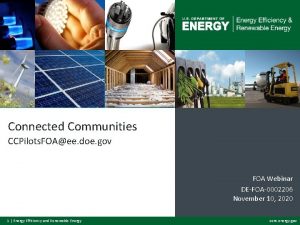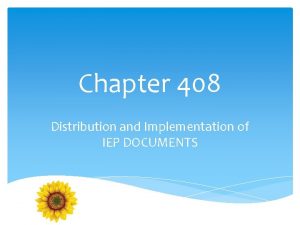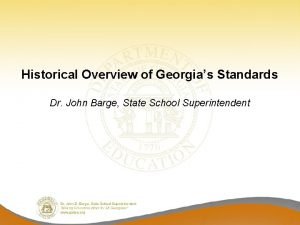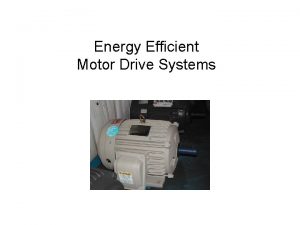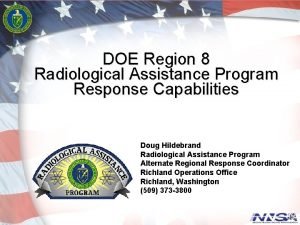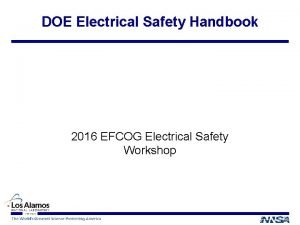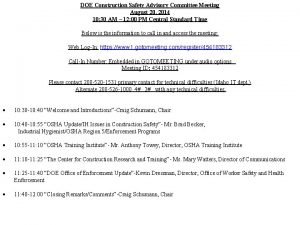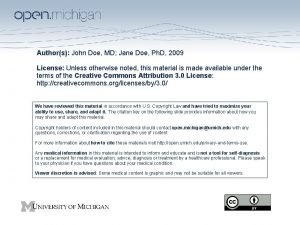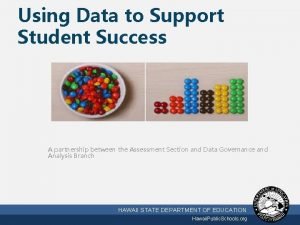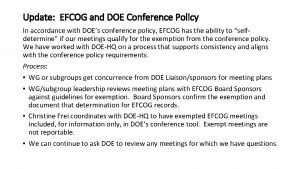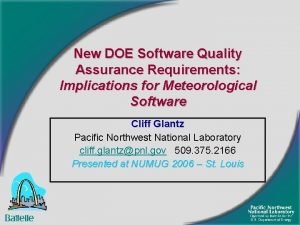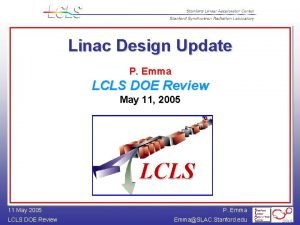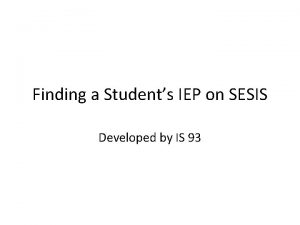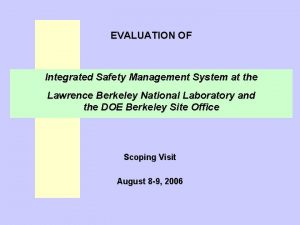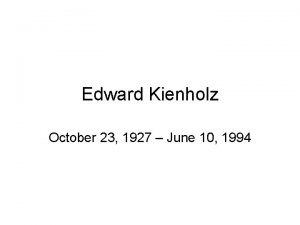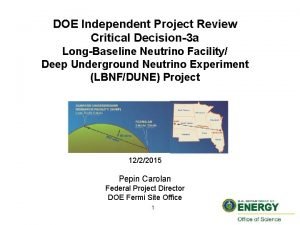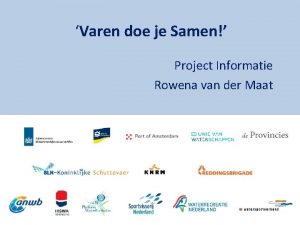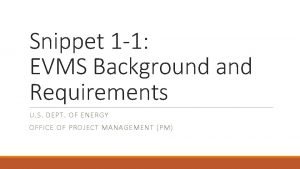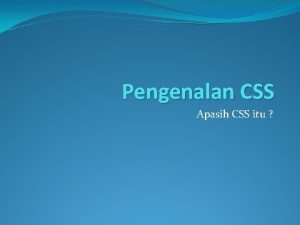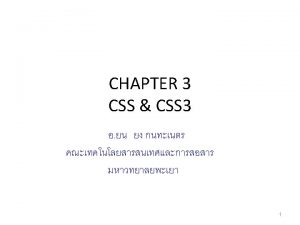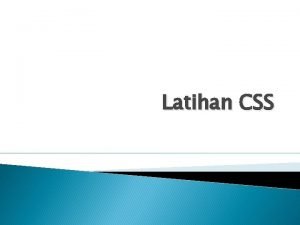DOE Program Managers Meeting with Principal Investigators CSS




















![Major Item of Equipment (MIE) Issues § We were not able to implement [most] Major Item of Equipment (MIE) Issues § We were not able to implement [most]](https://slidetodoc.com/presentation_image_h2/65546913f4647ed16f55416f34dcdc49/image-21.jpg)


























![Early Career (EC): Next Round in FY 14 § FY 14 FOA [DE‐FOA‐ 0000958] Early Career (EC): Next Round in FY 14 § FY 14 FOA [DE‐FOA‐ 0000958]](https://slidetodoc.com/presentation_image_h2/65546913f4647ed16f55416f34dcdc49/image-48.jpg)
























![Current LBNE Strategy § We are trying to follow the reconfiguration [phased] plan for Current LBNE Strategy § We are trying to follow the reconfiguration [phased] plan for](https://slidetodoc.com/presentation_image_h2/65546913f4647ed16f55416f34dcdc49/image-73.jpg)


- Slides: 75

DOE Program Managers’ Meeting with Principal Investigators CSS 2013 • Snowmass on the Mississippi Minneapolis, Minnesota July 29 – August 6, 2013 Abid Patwa Program Manager Office of High Energy Physics Office of Science, U. S. Department of Energy

Outline § § § Energy Frontier Program & Issues Budget and Issues FY 2014 HEP Comparative Review Process FY 2013 HEP Comparative Review Statistics Early Career Research Program Questions & Answers 2

Bs Candidate Event from CMS (Recorded 2012; pp collisions at 8 Te. V) Bs ® mm Decay Channel ENERGY FRONTIER PROGRAM

HEP Energy Frontier Experiments Experime Location nt CM Energy; Status Description # #US Institutions; Institutions Coll. # Countries DZero 1. 96 Te. V; Operations ended: Sept. 30, 2011 Higgs, Top, Electroweak, SUSY, New Physics, QCD, Bphysics 74 Institutions; 18 Countries 33 Univ. , 1 National Lab 192 1. 96 Te. V; Operations ended: Sept. 30, 2011 Higgs, Top, Electroweak, SUSY, New Physics, QCD, Bphysics 55 Institutions; 14 Countries 26 Univ. , 1 National Lab 224 7 -8 Te. V; 13 -14 Te. V Run 1 ended: Dec. 2012 Run 2 start: 2015 Higgs, Top, Electroweak, SUSY, New Physics, QCD, Bphysics, and Heavy. Ion 174 Institutions; 38 Countries 40 Univ. , 4 National Labs 556 Fermilab Tevatron Collider [Batavia, Illinois, USA] CDF (Collider Detector at Fermilab) ATLAS (A Toroidal LHC Apparatu. S) Fermilab Tevatron Collider [Batavia, Illinois, USA] CERN, Large Hadron Collider [Geneva, Switzerland / Meyrin, Switzerland] Collaboration data as of May 2013. CMS (Compact Muon Solenoid) CERN, Large Hadron Collider 7 -8 Te. V; 13 -14 Te. V Run 1 ended: Dec. 2012 Run 2 start: 2015 Higgs, Top, Electroweak, SUSY, New Physics, QCD, Bphysics, and Heavy. Ion 179 Institutions; 41 Countries 46 Univ. , 1 National Lab 676 [Geneva, comprises Switzerland / § US‐ATLAS ~21% of the international ATLAS Collaboration Cessy, France] § US‐CMS comprises ~33% of the international CMS Collaboration 4

Energy Frontier Status § Working with DØ and CDF collaborations on orderly completion of legacy analyses as part of its ramp-down program. Large Hadron Collider (LHC) at CERN § Run 1 (proton) completed in Dec. 2012 § Working with experiments to develop plan for contributions to “Phase-1” upgrades § CD-0 approval last September 2012 ($22 -34 M each experiment: ATLAS and CMS). § CD-1 reviews scheduled in August 2013. Completion of Run I; CMS & ATLAS recorded: ~22 fb -1 Total Integrated Luminosity [fb-1] Fermilab Tevatron (DØ and CDF) Day in 2012 Combined m = 0. 80 ± 0. 14 Current program § Analyze and publish results from LHC Run 1 § 2013 -2014 shutdown: repair splices in LHC magnets; detector maintenance and consolidation, upgrades and repairs § In 2015: resume running at 13~14 Te. V § Still no smoking guns for BSM physics § What will 13~14 Te. V running tell us? § Focus on new physics 1 s 2 s 3 s 4 s (Ref: SM Higgs boson: JP = 0+) JP = 0– JP = 1+ JP = 1– JP = 2+m ATLAS Spin-Parity CMS Signal Strength [Lepton-Photon 2013] 5

Planning § HEP is putting in place a comprehensive program across the frontiers – In five years, • The CMS and ATLAS upgrades will be installed at CERN • NOn. A, Belle‐II, Muon g‐ 2 will be running on the Intensity Frontier • Mu 2 e will be in commissioning, preparing for first data • DES will have completed its science program and new mid‐scale dark energy spectroscopic instrument and DM‐G 2 should begin operation • The two big initiatives, LSST and LBNE, will be well underway § Need to start planning now for what comes next – Engaging with DPF community planning process – [Snowmass] that will conclude this summer – Now setting up a prioritization process – [á la P 5] using that as input § Research funding will decrease for the next several years – Programmatic priorities and comparative reviews will be used to optimize the resources – See also ‘Budget’ slides, this talk… § Both the universities and the laboratories will be affected – University Comparative Reviews (held annually each ~Fall) – Lab Comparative Reviews in: Detector R&D (July 2012); Energy Frontier (July 2012); Accelerator Science (March 2013); Intensity Frontier (May 2013); Cosmic Frontier (this Sept. ) 6

Energy Frontier Issues § Discussions with CERN about follow‐on to LHC Agreement proceeding – Necessary precursor to planning for “Phase‐II” upgrades; US scope for “Phase‐II” TBD. § Energy Frontier science plan will require high‐energy, high‐luminosity LHC running – What is the real physics of the Te. V scale? • this will likely take a few years to sort itself out – US “Snowmass/P 5” process is an important element, along with European and Japanese HEP strategies § Significant collaborations with other regions on future colliders will require a high‐level approach between governments – Modest ground‐level R&D efforts can continue as funding allows – We support an international process to discuss future HEP facilities that respects the interests of major national and regional partners as well as realistic schedule and fiscal constraints – Once Snowmass/P 5 studies and the community input are complete, we will be in a better position to evaluate future US priorities for the HEP program in detail – We encourage active engagement by all interested parties 7

Energy Frontier Research: Next Steps and General Observations (I) § Tevatron – Complete ramp‐down of Tevatron research program during next ~ year with final physics results • Final statement on Higgs with full dataset & analysis improvements (this year) • Legacy measurements Tevatron – W mass (d. MW ® 10 Me. V) with ~10 fb‐ 1 – Top quark: precision mass, forward‐backward asymmetry – QCD, heavy‐flavor physics § General observations of Tevatron program – During peer‐conducted reviews, questions panelists frequently must answer • are results from the analysis superseded by the LHC experiments (CMS, ATLAS, or LHCb)? • is the analysis “publishable” within reasonable timescales? § As budgets continue to be under pressure, guidance provided to complete Tevatron analyses efforts as soon as possible 8

Energy Frontier Research: Next Steps and General Observations (II) § LHC – Discovery of Higgs‐like boson by CMS and ATLAS measure properties: couplings, spin/parity • is it consistent with one predicted in SM? – Publish physics results with √s = 8 Te. V data [Run I] • Higgs, top, and electroweak measurements • Search for new physics BSM: exotic particles, SUSY, … • QCD, heavy‐flavor physics Solid – 5 s discovery Dashed – 95% exclusion § … and steps in next ~5 years – LHC will increase energy (√s = 13~14 Te. V) and luminosity (L > 1034 cm‐ 2 s‐ 1) for 2015‐ 2017 Run 2 (~100 fb‐ 1); and post‐Phase‐ 1: 2019‐ 2021 Run 3 (~300 fb‐ 1) • expand sensitivity reach for new physics – Phase‐ 1 upgrade activities will mix with physics research‐related efforts • proposals are encouraged to address a balanced effort in both § Other general observations – Encourage community to exploit and interact with LHC Physics Center (LPC, CMS) or Analysis Support Center (ASC, ATLAS) 9

HEP BUDGETS

DOE OHEP Organization 11

HEP Budget Overview § FY 2014 budget philosophy was to enable new world‐leading HEP capabilities in the U. S. through investments on all three frontiers – Accomplished through ramp‐down Research and operations of existing Projects – When we were not able to fully implement this approach (i. e. , start new projects), converted planned project funds to R&D: Research Projects Research • Therefore, the FY 14 Request shows increases for Research that are due to this added R&D “bump”, while Construction/project funding is only slightly increased • In the interim (since submission of FY 14 Request), actual FY 13 Research funding also increased because of inability to get projects started • Initial FY 14 plan for Research will be down more than the originally advertised 2‐ 3% relative to FY 13 § § – Details in following slides… Impact of these actions: – Several new efforts are delayed: • LHC detector upgrades, LBNE, 2 nd Generation Dark Matter detectors, MS‐DESI – US leadership/partnership capabilities will be challenged by others – Workforce reductions at universities and labs Key areas in FY 2014 Request – Maintaining forward progress on new projects via Construction and Research (incl. R&D for projects) funding lines 12

Recent Funding Trends 70. 0% 60. 0% Ramp up ILC and SRF R&D programs Trading Projects for more Research 50. 0% Research 40. 0% Facilities Projects 30. 0% Other 20. 0% 10. 0% • • • FY 2014 FY 2013 FY 2012 FY 2011 FY 2010 FY 2009 FY 2008 FY 2007 FY 2006 FY 2005 FY 2004 FY 2003 FY 2002 FY 2001 FY 2000 FY 1999 FY 1998 FY 1997 FY 1996 0. 0% In the late 90’s the fraction of the budget devoted to projects was about 20%. Progress in many fields require new investments to produce new capabilities. The projects started in 2006 are coming to completion. New investments are needed to continue US leadership in well defined research areas. Possibilities for future funding growth are weak. Must make do with what we have. 13

One Possible Future Scenario Trading Research for more Projects • About 20% (relative) reduction in Research fraction over ~5 years § In order to address priorities, this will not be applied equally across Frontiers • This necessarily implies reductions in scientific staffing § Some can migrate to Projects but other transitions are more difficult • We have requested Labs to help manage this transition as gracefully as possible 14

FY 2014 High Energy Physics Budget (Data in new structure, dollars in thousands) Description FY 2012 Actual FY 2013 July Plan FY 2014 Request Explanation of Change [FY 14 Request vs. FY 12 Actual] Energy Frontier Exp. Physics 159, 997 148, 164 154, 687 Intensity Frontier Exp. Physics 283, 675 287, 220 271, 043 Ramp-down of Tevatron Research Completion of NOn. A (MIE), partially offset by Fermi Ops Cosmic Frontier Exp. Physics Theoretical and Computational Physics 71, 940 78, 943 99, 080 Ramp-up of LSST-Camera 66, 965 66, 398 62, 870 Continuing reductions in Research Advanced Technology R&D 157, 106 131, 885 122, 453 2, 850 3, 132 9, 931 Completion of ILC R&D FY 14 includes Stewardship-related Research 0 0 21, 457 28, 000 11, 781 35, 000 Total, High Energy Physics: 770, 533 (a) 727, 523 (b, c) Ref: Office of Science (SC): 4, 873, 634 4, 621, 075 (c) 5, 152, 752 Accelerator Stewardship SBIR/STTR Construction (Line Item) (a) The Mostly Mu 2 e; no LBNE ramp-up wrt FY 13: Up +3. 6% after SBIR correction 776, 521 wrt FY 12: Down ‐ 2% after SBIR correction FY 2012 Actual is reduced by $20, 327, 000 for SBIR/STTR. (b) The FY 2013 [July Plan] is reduced by $20, 791, 000 for SBIR/STTR. SBIR = Small Business Innovation Research STTR = Small Business Technology Transfer (c) Reflects sequestration. 15

HEP Energy Frontier Funding (in $K) FY 2012 Actual FY 2013 July Plan FY 2014 Request Comment Tevatron ramp-down offset by R&D for LHC detector upgrades Research 91, 757 86, 172 96, 129 (a) Facilities 68, 240 61, 992 58, 558 64, 846 (b) 56, 912 56, 774 LHC down for maintenance 0 3, 000 0 LHC detector upgrades (OPC) 3, 394 2, 080 1, 784 IPAs, Detailees, Reviews 159, 997 148, 164 154, 687 LHC Detector Ops LHC Upgrade Project Other TOTAL, Energy Frontier: OPC = Other Project Costs (a) Includes $12 M (= $6 M CMS + $6 M ATLAS) Phase‐ 1 detector upgrades [R&D]; Therefore, Energy Frontier Core Research FY 14 Request = 84, 129 k (b) Per interagency MOU, HEP provided LHC Detector Ops funding during FY 12 CR to offset NSF contributions to Homestake de‐watering activities. 16

($M) Energy Frontier Research Budget Fiscal Year § FY 13 core research budget saw reduction of ~6% relative to FY 12 – driven by completion of Tevatron run [September 2011] and subsequent end‐game of Tevatron physics program 17

($M) Energy Frontier Research Budget Supports: 1) Funding [low-level, e. g. , FY 13 total = $68 k] of EF-related conferences or workshops at universities or laboratories Fiscal Year § FY 13 core research budget saw reduction of ~6% relative to FY 12 – driven by completion of Tevatron run [September 2011] and subsequent end‐game of Tevatron physics program 17

($M) Energy Frontier Research Budget Fiscal Year Mainly Supports: 1) Bridge Funding 2) Grant continuations 3) Comparative Review proposals 4) Supplements 5) University Service Accounts (at labs) § FY 13 core research budget saw reduction of ~6% relative to FY 12 – driven by completion of Tevatron run [September 2011] and subsequent end‐game of Tevatron physics program 17

($M) Energy Frontier Research Budget Fiscal Year Mainly Supports: 1) ANL 2) BNL 3) Fermilab 4) LBNL 5) SLAC 6) Fellows prgm. to universities (US-ATLAS, US-CMS LPC) § FY 13 core research budget saw reduction of ~6% relative to FY 12 – driven by completion of Tevatron run [September 2011] and subsequent end‐game of Tevatron physics program 17
![Major Item of Equipment MIE Issues We were not able to implement most Major Item of Equipment (MIE) Issues § We were not able to implement [most]](https://slidetodoc.com/presentation_image_h2/65546913f4647ed16f55416f34dcdc49/image-21.jpg)
Major Item of Equipment (MIE) Issues § We were not able to implement [most] new MIE‐fabrication starts in the FY 14 request Brookhaven National Laboratory Muon g-2 Ring: On Barge, Departing Southern Long Island June 25, 2013 On Barge, Through Joliet Locks; July 20, 2013 – Muon g‐ 2 experiment is the only new start in HEP that was not requested in FY 13 – LSST‐Camera and Belle‐II, which didn’t receive approval in FY 13, are requested again in FY 14 Entering Fermilab-site, Eola Rd. Gate; July 26, 2013 § This upsets at least 2 major features of our budget strategy: – Strategic plan: “Trading Research for Projects” – Implementation of facilities balanced across Frontiers 18

HEP Physics MIE Funding (in $K) MIE’s Intensity Frontier FY 2012 FY 2013 FY 2014 Actual July Plan Request 55, 770 45, 687 39, 000 41, 24 0 19, 480 0 Description NOn. A ramp-down Intensity Frontier 6, 000 5, 857 Intensity Frontier 500 0 Intensity Frontier 1, 030 5, 000 8, 000 Belle-II Intensity Frontier 0 5, 850 9, 000 Muon g-2 Experiment 1, 500 0 Cosmic Frontier TOTAL MIE’s 0 Micro. Boo. NE Reactor Neutrino Detector 0 at Daya Bay 5, 500 8, 000 22, 000 55, 770 45, 687 39, 000 HAWC Large Synoptic Survey Telescope (LSST) Camera 19

HEP Physics Construction Funding FY 2012 FY 2013 FY 2014 Actual July Plan Request 53, 000 28, 388 45, 000 21, 0 00 17, 888 10, 000 Funding (in $K) Construction ‐ TPC Long Baseline Neutrino Experiment TEC 4, 000 3, 781 0 OPC 17, 000 14, 107 10, 000 TPC 21, 000 17, 888 32, 0 00 10, 500 10, 000 Muon to Electron Conversion Experiment 35, 000 TEC 24, 000 8, 000 35, 000 OPC 8, 000 2, 500 0 TPC 32, 000 10, 500 35, 000 TEC = Total Estimated Cost (refers to Capital Equipment expenses) OPC = Other Project Costs TPC = Total Project Cost 20

FY 2014 HEP COMPARATIVE REVIEW PROCESS

Purpose § In FY 2012, DOE/HEP started a process of comparative grant reviews for research grants which were scheduled for renewal (+ any new proposals as desired) – Existing grants which did not renew in FY 2012 (“continuations”) were not affected by this change in the 1 st round § § Previously all HEP proposals responding to the general Office of Science (SC) call were individually peer‐reviewed by independent experts. This change in process has been recommended by several DOE advisory committees, most recently the 2010 HEP Committee of Visitors (COV): – “In several of the cases that the panel read, proposal reviewers expressed negative views of the grant, but only outside of their formal responses. Coupled with the trend in the data towards very little changes in the funding levels over time, this suggests that grants are being evaluated based on the historical strength of the group rather than the current strength or productivity of the group. This is of particular concern when considering whether new investigators, new science, or high‐risk projects can be competitive. Comparative reviews can be a powerful tool for addressing these issues and keeping the program in peak form. ” – Recommendation: Use comparative review panels on a regular basis. § Currently with the FY 14 FOA, we are in 3 rd round of annual comparative review process § The goal of this effort is to improve the overall quality and efficacy of the HEP research program by identifying the best proposals with highest scientific impact and potential 22

FY 14 HEP Comparative Review FOA § DE‐FOA‐ 0000948 • Issued June 14, 2013 § Six HEP research subprograms • Energy, Intensity, and Cosmic Frontiers • HEP Theory • Accelerator Science and Technology R&D • Particle Detector R&D § Letter of Intent due July 15, 2013 by 5 PM Eastern Time • Strongly encouraged 23

FY 14 HEP Comparative Review FOA § DE‐FOA‐ 0000948 • Issued June 14, 2013 § Six HEP research subprograms • Energy, Intensity, and Cosmic Frontiers • HEP Theory • Accelerator Science and Technology R&D • Particle Detector R&D Letter of Intent due July 15, 2013 by 5 PM Eastern Time • Strongly encouraged • as of today, deadline has past 23

FY 14 HEP Comparative Review FOA § DE‐FOA‐ 0000948 • Issued June 14, 2013 § Six HEP research subprograms • Energy, Intensity, and Cosmic Frontiers • HEP Theory • Accelerator Science and Technology R&D • Particle Detector R&D Letter of Intent due July 15, 2013 by 5 PM Eastern Time • Strongly encouraged § Final Proposal (i. e. , Application) deadline Sept. 9, 2013 by 11: 59 PM Eastern Time 23

Frequently Asked Questions (FAQs) § FAQ for FY 14 HEP Comparative Review • available at: http: //science. energy. gov/~/media/hep/pdf/files/pdfs/Funding%20 Opportunities/ FY 14_Comp_Review_FAQUPDATED_JULY 11_2013. pdf • updated: July 11, 2013 § In addition to information provided in FOA, FAQ addresses topics on: • • Eligibility requirements Proposal types and scope of proposals being considered Guidance for new faculty members and those without current HEP grants Guidance for PIs with existing HEP grants Letter of Intent Proposal and Application requirements Budgets information, including guidance on scope of request(s) Information on overall scientific merit review process 24

HEP Data Management Effective with all solicitations and invitations for research funding issued on or after October 1, 2013. The DOE Office of Science Statement on Digital Data Management will require a Data Management Plan with all proposals submitted for Office of Science research funding. See March 12, 2013 HEPAP presentation by Laura Biven: http: //science. energy. gov/~/media/hepap/pdf/march‐ 2013/2013_Spring_HEPAPBriefing_v 3_No. Backup_LBiven. pdf More information will also be available in the FOAs, via the DOE Office of Science website, and on the High Energy Physics webpage. Note: Proposals submitted to the FY 14 HEP Comparative Review FOA [DE‐FOA‐ 0000948] or to the FY 14 Early Career Research Program FOA [DE‐FOA‐ 0000958] that have already been posted will not require Data Management Plans. 25

Logistics (FY 14 Comparative Review) § Post‐FOA deadline • • § For review process, experts of panelists selected • § Each panelist assigned to review 3‐ 5 proposals – minimum 3 reviews per proposal, additional reviewers added depending on the size of a research group and scope of research activities – Panel convenes (in ~November 2013) to discuss each proposal and each senior investigator, provide additional reviews for proposal(s), and for comparative evaluation of proposals and senior investigators • size of each subprogram’s panel and length of a panel meeting depends on number of applications to review Post‐Review process • • § All applications are pre‐screened for compliance to FOA, includes: – verification of senior investigator status – compliance with proposal requirements: e. g. , page limits, appendix material, use of correct DOE budget and budget justification forms, … – responsive to subprogram descriptions Prior to submission, all PIs should carefully follow guidelines in FOA (and read FAQ) Assess reviews at DOE OHEP on each proposal and each senior investigator in order to develop guidance and funding levels – in addition to reviews, solicit input from other DOE Program Managers & Grant Monitors PIs given [prioritized] guidance and funding levels (~mid‐January 2014) and request Revised Budgets and Justifications route through SC and Chicago Office Funded grants to begin 1 st year: on or about May 1, 2014 26

HEP Research Activities Supported § What DOE supports – Research efforts (mainly scientists) on R&D, experiment design, fabrication, data‐taking, analysis‐related activities – Theory, simulations, phenomenology, computational studies – Some engineering support may be provided in Particle Detector R&D subprogram • support depends on merit review process and programmatic factors – Consider funding efforts that are in direct support of our programs § Faculty support – Typically, 2‐months summer support assumes DOE “buys” 100% research time throughout the academic year – Summer support should be adjusted according to % time they are on research effort • associated funding (post‐docs, travel) is also adjusted accordingly § Research Scientists – Support may be provided, but due to long‐term expectations, need to consider case‐by‐case on merits: whether the roles and responsibilities are well‐matched with individual capabilities and cannot be fulfilled by a term position – Efforts are related towards research; not long‐term operations and/or project activities × What’s not supported by research grants – Any significant operations and/or project‐related activities: • Engineering, major items of equipment, consumables for prototyping or production – Non‐HEP related efforts • Gravity waves (LIGO), Heavy Ion (RHIC), AMO Science, etc. 27

Subprogram Review Panels § The Comparative Review process is very competitive and hard choices have to be made based on the reviews, as well as to fit into our limited funding availability – The process by definition implies that certain proposals and investigators will be ranked at the top, middle, and bottom. § It is understood that the vast majority of people applying are working hard and their efforts are in support of the HEP program. Due to the rankings & comments by the reviewers and our constrained budgets, some people whose research activities and level of effort who are ranked lower in terms of priority and impact relative to others in the field will not be funded on the grant – This does not necessarily mean the person cannot continue working on the experiments; they are not being funded by the grant to do it. It could be that the person has a critical role in the program but this did not come out in the proposal or review process. That is why it is imperative to respond to the FOA solicitation and detail each person’s efforts. § The subprogram review panel sees all of the proposals and will make recommendations and rankings relative to each other. When the panel is faced with comparing efforts, impacts and a limited budget, rather than rank the whole proposal low, they may provide guidance regarding details of the proposals – e. g. , person X should not be funded; do not additional postdoc on this effort 28

Programmatic Considerations § Generally very useful to have head‐to‐head reviews of PIs working in similar areas, particularly for large grants § Lots of discussion of relative strengths and weaknesses of individual proposals and PIs § Many factors weigh into final funding decisions – Compelling research proposal for next ~3 years Interesting? Novel? Significant? Plausibly achievable? x Incremental? Implausibly ambitious? Poorly presented? – Significant recent contributions in last 3‐ 4 years • Synergy and collaboration within group (as appropriate) • Contributions to the research infrastructure of experiments – Alignment with programmatic priorities § Supportive of excellent people, including excellent new people, even when times are tough! 29

Comparative Review Criteria (In descending order of importance) § 1. Scientific and/or Technical Merit of the Project For e. g. , what is the likelihood of achieving valuable results? How might the results of the proposed research impact the direction, progress, and thinking in relevant scientific fields of research? How does the proposed research compare with other research in its field, both in terms of scientific and/or technical merit and originality? Please comment individually on each senior investigator. § 2. Appropriateness of the Proposed Method or Approach For e. g. , how logical and feasible is the research approach of each senior investigator? Does the proposed research employ innovative concepts or methods? Are the conceptual framework, methods, and analyses well justified, adequately developed, and likely to lead to scientifically valid conclusions? Does the applicant recognize significant potential problems and consider alternative strategies? § 3. Competency of Research Team and Adequacy of Available Resources For e. g. , what are the past performance and potential of each senior investigator? How well qualified is the research team to carry out the proposed research? Are the research environment and facilities adequate for performing the research? Does the proposed work take advantage of unique facilities and capabilities? § 4. Reasonableness and Appropriateness of the Proposed Budget Are the proposed resources and staffing levels adequate to carry out the proposed research? Is the budget reasonable and appropriate for the scope? § 5. Relevance to the mission of the Office of High Energy Physics (HEP) program How does the proposed research of each senior investigator contribute to the mission, science goals and programmatic priorities of the subprogram in which the application is being evaluated? I s it consistent with HEP’s overall mission and priorities? How likely is it to impact the mission or direction of the HEP program? § 6. General Comments and Overall Impression Include any comments you may wish to make on the overall strengths and weaknesses of the proposal, especially as compared to other research efforts in this area. If there are significant or unique elements of the overall proposal, including institutional setting and resources, synergies with other relevant subprograms, or other broader considerations noted above please include them here. 30

Scoring by Panelists Table A: Scoring system definition. Qualifier Poor Fair Good Very Good Excellent Outstanding Score 1 2 3 4 5 6 § Using the grading system in Table A above, please provide scores for the overall proposal in the respective Energy Frontier subprogram area. • Please provide scores from 1 [Poor] to 6 [Outstanding] for each of the five criteria in Sections 1‐ 5 in Table B below. Your scores should be supported by your answers to questions 1‐ 5. Table B: Overall Score in the Energy Frontier. Criterion Overall Score [1 to 6] 1) Scientific Merit 2) Appropriateness 3) Competency 4) Budget 5) Mission Relevance 31

Rating by Panelists Table C: In comparison with similar Energy Frontier research efforts, please indicate whether you judge this program to lie in the bottom, 2 nd, 3 rd, 4 th, or top quintile. Enter an “X” in the appropriate box. Bottom 1 -20% Bottom 21%-40% Mid 41%-60% Top 61%-80% Top 81%-100% § Next, for each senior investigator listed in Table D, provide scores for the following [two] criteria: – (1) the merit and potential impact of the proposed work – (2 a) the competency of the investigator and the likelihood of success. Use grading system defined in Table A. – (2 b) compared to other senior investigators working in the same area at this and other institutions, how would you rank this investigator overall in terms of quintiles? • Please put an “X” in the appropriate box in Table D. Your ratings below should be supported by your answers to questions 1 to 5 and the scores in Table D itself. Table D: Individual Energy Frontier senior investigator scores. Senior Investigator #1 Senior Investigator #2 Senior Investigator #3 Scientific merit Competency Compared to other senior investigators working in the of senior and potential same area, how would you rank this senior investigator’s impact of investigator overall? Please enter one “X” per senior team and proposed work investigator in one of the columns below. likelihood of success [enter 1 to 6] Bottom Mid Top [enter 1 to 6] 1%-20% 21%-40% 41%-60% 61%-80% 81%-100%

Comparative Evaluation § DOE Program Managers will need to determine: – The threshold for funding each proposal – The level of support for each funded proposal § A “comparative” evaluation: – Reviewer scores / rankings of the proposals and senior investigators provide essential (additional) input to DOE’s process of optimizing resource allocations for the University research program – Not everyone can be “Above Average” 33

FY 2013 HEP COMPARATIVE REVIEW STATISTICS

FY 13 Submitted Proposals § FY 2013 cycle: – 185 proposals requesting support totaling $335. 782 M in one or more of the six sub‐programs received by the September 10, 2012 deadline in response to “FY 2013 Research Opportunities in High Energy Physics” [DE‐FOA‐ 0000733] § After pre‐screening all incoming proposals for responsiveness to the subprogram descriptions and for compliance with the proposal requirements: 12 were declined before the competition – There were hard page limits and other requirements. Proposals not respecting the page limits or other requirements were NOT reviewed • 5 proposals declined without review for this reason • 1 proposal was missing a research narrative • 4 were outside the scope of HEP • 2 proposals were non‐responsive – PIs with proposals that were rejected for “technical” reasons could re‐submit to general DOE/SC solicitation § 11 proposals were withdrawn by the respective sponsoring institutions – 4 were duplicate submissions – 6 were supplemental requests submitted to the incorrect FOA – 1 proposal was submitted from a federal agency which was ineligible 35

FY 13 Reviewers & Panels § For the FY 13 HEP Comparative Review process, 162 submitted proposals reviewed, evaluated and discussed by several panels of experts who met in the 6 HEP subprograms: Subprogram Panel Deliberations # of Total Proposals [includes proposals containing multiple subprograms] Intensity Frontier Theory November 5‐ 6, 2012 November 6‐ 8, 2012 31 53 Particle Detector R&D November 8‐ 9, 2012 22 November 13‐ 15, 2012 45 November 13‐ 14, 2012 November 14‐ 16, 2012 40 28 Energy Frontier Accelerator Science and Technology R&D Cosmic Frontier § 30 of the proposals requested research support from 2 or more of the 6 subprograms, e. g. , “umbrella” proposals – In such cases, the proposal was sent in its entirety to all relevant panels – However, the panels were asked to explicitly compare and rank only the section(s) of the proposal relevant to the sub‐program they were reviewing § Each proposal that satisfied the requirements of the solicitation was sent out for review by at least 3 experts and then subsequent comparative evaluation by the panel – 130 reviewers participated in the review process • for proposals on similar topics, reviewers were sent multiple proposals – 834 reviews were completed with an average 5. 2 reviews per proposal 36

FY 13 Review Data by Proposal Received Declined/Withdrawn Without Reviewed Funded Declined “Success Rate” (%) (Previous/New) Energy Intensity Cosmic Theory Acc. R&D Det. R&D HEP Total 46 33 33 56 44 30 185 1 2 5 3 4 8 23 45 (1) 31 (5) 28 (14) 53 (11) 40 (21) 22 (14) 162 (58) 40(a) (0) 24 (3) 18 (4) 35 (4) 17(b) (3) 12 (6) 101 (20) 5 (1) 7 (2) 10 (10) 18 (7) 23 (17) 10 (8) 61 (38) 89 77 64 66 43 55 62 (78/34) NOTES: • Single proposals with multiple research subprograms are counted multiple times (1 /subprogram) • ( ) indicates number of proposals from research groups that did not receive DOE HEP funding in FY 12. • “Success Rate” is = # Funded/ # Reviewed. • Most proposals are not fully funded at requested level. • About 68% of the proposals reviewed were from research groups that received DOE HEP funding in FY 12. • Overall success rate of reviewed proposals for previously (newly) funded groups was 78% (34%). (a) 3 (b) 5 of 40 Energy funded proposals were provided term support (<1 year) for graduate students and post-docs. of 17 Accelerator R&D funded proposals were provided term support (<1 year). 37

FY 13 Review Data by Senior Investigator Energy Intensity Cosmic Theory 127 56 61 155 57 47 504 1 2 8 9 4 18 42 Reviewed 126 (7) 54 (8) 54 (30) 146 (24) 53 (25) 29 (19) 462 (113) Funded 112 (3) 43 (6) 27 (7) 115 (11) 24 (4) 19 (9) 338 (40) Declined 14 (4) 11 (2) 26 (23) 31 (13) 29 (21) 13 (10) 124 (73) 89 80 51 79 45 53 73 (85/35) Received Declined/Withdrawn Without Review “Success Rate” (%) (Previous/New) Acc. R&D Det. R&D HEP Total NOTES: • ( ) indicates number of senior investigators that did not receive DOE HEP funding in FY 12. • “Success Rate” is = # Funded/ # Reviewed. • Overall success rate for previously (newly) funded DOE HEP PIs was 85% (35%). • Most (but not all) PIs who are funded, are funded at requested effort level. 38

FY 13 Review Data Jr. Faculty and Research Scientists Accelerator R&D Total # Jr. Faculty Reviewed (New) Funded (New) 7 (7) 1 (1) Total # Res. Scientists Reviewed (New) 34 (11) # Res. Scientists Funded (New) 20 (0) Cosmic Frontier Detector R&D Energy Frontier 10 (8) 3 (2) 16 (3) 3 (3) 1 (1) 15 (2) 2 (2) 10 (5) 28 (2) 0 (0) 6 (2) 18 (1) * 7 (5) 13 (6) 40 (18) 5 (0) 3 (0) 81 (20) 4 (0) 0 (0) 47 (3) Intensity Frontier 9 (5) 15 (7) Theory 60 (32) HEP Total * DOE worked with US-CMS and US-ATLAS management to find support for fraction of needed Research Scientists through the LHC Ops program. 39

More on Research Scientists (RS) § § Efforts of all RS that have support requested in a proposal are evaluated by the panel See also Q&A‐ 40 of FAQ… – Requests to support RS dedicated full‐time (and long‐term) to operational and/or project activities for an experiment will not be supported by respective frontier research areas – If RS conducting physics research‐related activities, requests [scaled to % of time on such efforts] can be included • any final support will be based on the merit review process § Common reviewer comments that result in unfavorable merit reviews: – ‘RS conducting scope of work typically commensurate at the postdoctoral‐level…’ – ‘RS involved in long‐term operation/project activities with minimum physics research efforts…’ • such efforts may review well in a DOE review of the operation/project program but not as well in a review of the experimental research program § What is physics research‐related activities? – Object reconstruction/algorithm development, performance studies, data taking and analysis, and mentorship of students & postdocs in these areas – Scientific activities in support of detector/hardware design and development § From the research program, cases become an issue when operations/projects become the dominant activity long‐term – A well‐balanced portfolio that includes physics research‐related activities is encouraged 40

FY 13 Proposals vs. FY 12 Status New Up Flat Down No‐Fund Decline Total Accelerator R&D 3 2 4 8 6 17 40 Cosmic Frontier Detector R&D Energy Frontier Intensity Frontier 4 6 0 7 2 10 1 2 2 6 2 28(a) 0 2 1 10 8 4 28 22 45 3 4 20 8 2 20 6 7 14 7 22 48 5 11 22 2 7 38 31 53 162 Theory HEP Total • Single proposals with multiple research subprograms are counted multiple times (1 /subprogram) • New = HEP research effort was not funded at this institution in FY 12. • Up = FY 13 funding level +2% or more compared to FY 12. • Flat = FY 13 funding level within ± 2% of FY 12. • Down = FY 13 funding -2% or more compared to FY 12. • No-Fund = No funding is provided in FY 13. This effort was funded in FY 12. • Decline = This effort was not funded in FY 12. § Energy Frontier: 45 proposals reviewed in FY 13 – request: $31. 3 M (12 -month); funded: $18 M of 28 proposals had Tevatron (CDF or D 0) research activities associated with them in addition to CMS/ATLAS research activities. In general, the Tevatron efforts saw a downward reduction with respect to FY 12. (11 -month) (a) 11 41

EARLY CAREER RESEARCH PROGRAM (ECRP)
![Early Career EC Next Round in FY 14 FY 14 FOA DEFOA 0000958 Early Career (EC): Next Round in FY 14 § FY 14 FOA [DE‐FOA‐ 0000958]](https://slidetodoc.com/presentation_image_h2/65546913f4647ed16f55416f34dcdc49/image-48.jpg)
Early Career (EC): Next Round in FY 14 § FY 14 FOA [DE‐FOA‐ 0000958] posted on July 23, 2013 at the Early Career website: – http: //science. energy. gov/early‐career/ § Read the FY 14 FAQ, also on above web site – addresses most of the common Q&A collected over the last 4 years § Features of FY 14 – Entering 5 th year • some population of candidates will no longer be eligible due to the “ 3‐strikes rule” – Mandatory Pre‐application requirement. Two pages. • Deadline: September 5, 2013, 5 PM Eastern • all interested PIs encouraged to register as soon as possible in DOE/SC Portfolio Analysis and Management System (PAMS) for submission [link provided in EC website] – Full proposals due: November 19, 2013, 5 PM Eastern • candidates will have more than 3 months to develop a plan, write a narrative, and submit an application § Presidential Early Career Awards for Scientists and Engineers (PECASE) – PECASE‐eligible candidates are selected from the pool of Early Career awardees • http: //science. energy. gov/about/honors‐and‐awards/pecase/ 43

HEP Early Career General Observations § Reviewers often look for innovative proposals – Usually something a bit off the beaten track that the PI can claim as their own • during preparation, PIs should address “why is it critical that I carry‐out this research? ” § – Somewhat speculative but not too risky – Provide unique capabilities. What does not get done? In experimental HEP proposals that are submitted to ECRP FOA – Looking for a balanced program • strong physics effort and hardware project attached to an experiment (e. g. , Phase‐ 1 upgrades for LHC) § § § Many lab and some university proposals suffered from “isn’t the lab/project going to do that anyway? ” – Some proposals were clear efforts to start funding some project or R&D that HEP has not yet approved – “the camel’s nose under the tent” – The theory lab proposals were questioned on cost‐effectiveness Prior to submission, applicants may want to seek guidance from senior faculty and/or staff while preparing proposals (including budget material) Because different reviewers weigh the criteria differently (or have their own physics biases) there is a larger spread in panel rankings 44

HEP Early Career FY 10 -13 Demographics L = National Laboratory Proposal U = University Proposal Subprogram Awards FY 10 (L/U) FY 11 (L/U) FY 12 (L/U) FY 13 (L/U) Total (L/U) Energy 3 (1/2) 1 (0/1) 2 (0/2) 9 (2/7) Intensity 2 (1/1) 1 (0/1) 3 (2/1) 1* (0/1) 7 (3/4) Cosmic 2 (0/2) 3 (2/1) 3 (1/2) 2 (1/1) 10 (4/6) HEP Theory 6 (1/5) 4 (0/4) 3 (0/3) 3 (1/2) 16 (2/14) Accelerator 1 (1/0) 2 (2/0) 2 (1/1) 1 (0/1) 6 (4/2) HEP Awards 14 (4/10) 13 (5/8) 12 (4/8) 9 (2/7) 48 (15/33) Proposals 154 (46/108) 128 (43/85) 89 (34/55) 78 (29/49) 449 (152/297) * Funded by DOE Office of Basic Energy Sciences (BES) as an EPSCo. R [Experimental Program to Stimulate Competitive Research] award with grant monitored by DOE Office of High Energy Physics (HEP). § Early Career Research Program is very competitive (~10% success rate) 45

EC Recipients: Energy Frontier § FY 10 § § § “Model‐Independent Dark‐Matter Searches at the ATLAS Experiment and Applications of Many‐core Computing to High Energy Physics” ― Dr. Amir Farbin (ATLAS Experiment) University of Texas, Arlington “Diamond Pixel Luminosity Telescopes” ― Dr. Valerie Halyo (CMS Experiment) Princeton University “Enhancing the LHC Discovery Potential with Jets, Missing ET, and bit ‐tagging Physics Signature Reconstruction in ATLAS” ― Dr. Ariel Schwartzman (ATLAS Experiment) SLAC National Accelerator Laboratory “Taus and the Trigger for Discovery at ATLAS” ― Dr. Sarah Demers (ATLAS Experiment) Yale University FY 11 § “Precision Physics and Searches with Top and Bottom Quarks” ― Dr. Aran Garcia-Bellido (CMS Experiment) University of Rochester “Enhancement of the Trigger Capability for New Physics at the Large Hadron Collider” ― Dr. Jinlong Zhang (ATLAS Experiment) Argonne National Laboratory § “Search for New Physics and Upgrade of the Muon Spectrometer at ATLAS” ― Dr. Junjie Zhu (ATLAS Experiment) University of Michigan, Ann Arbor § “Quest for a Top Quark Partner and Upgrade of the Pixel Detector Readout Chain at the CMS” ― Dr. Andrew Ivanov (CMS Experiment) Kansas State University FY 13 FY 12 § § “Search for the Higgs and Physics Beyond the Standard Model with the CMS Electromagnetic Calorimeter” ― Dr. Toyoko J. Orimoto (CMS Experiment) Northeastern University

EC Recipients: Energy Frontier § FY 10 § § § FY 11 § § “Model‐Independent Dark‐Matter Searches at the ATLAS Experiment and Applications of Many‐core Computing to High Energy Physics” ― Dr. Amir Farbin (ATLAS Experiment) University of Texas, Arlington “Diamond Pixel Luminosity Telescopes” ― Dr. Valerie Halyo (CMS Experiment) Princeton University “Enhancing the LHC Discovery Potential with Jets, Missing ET, and bit ‐tagging Physics Signature Reconstruction in ATLAS” ― Dr. Ariel Schwartzman (ATLAS Experiment) SLAC National Accelerator Laboratory “Taus and the Trigger for Discovery at ATLAS” Congratulations ― Dr. Sarah Demers (ATLAS Experiment) to recipients in the Yale University Energy research program, “Precision Physics and Searches with Top. Frontier and Bottom Quarks” ― Dr. Aran Garcia-Bellido (CMS Experiment) and University of Rochester Congratulations to Collider” all “Enhancement of the Trigger Capability for New Physics at the Large Hadron ― Dr. Jinlong Zhang (ATLAS Experiment) Early Career Research Award recipients! Argonne National Laboratory “Search for New Physics and Upgrade of the Muon Spectrometer at ATLAS” ― Dr. Junjie Zhu (ATLAS Experiment) University of Michigan, Ann Arbor § “Quest for a Top Quark Partner and Upgrade of the Pixel Detector Readout Chain at the CMS” ― Dr. Andrew Ivanov (CMS Experiment) Kansas State University FY 13 FY 12 § § “Search for the Higgs and Physics Beyond the Standard Model with the CMS Electromagnetic Calorimeter” ― Dr. Toyoko J. Orimoto (CMS Experiment) Northeastern University

REFERENCE SLIDES

Office of High Energy Physics Fundamental to the Frontiers of Discovery HEP’s Mission: To explore the most fundamental questions about the nature of the universe at the Cosmic, Intensity, and Energy Frontiers of scientific discovery, and to develop the tools and instrumentation that expand that research. HEP seeks answers to Big Questions: How does mass originate? Why is the world matter and not anti-matter? What is dark energy? Dark matter? Do all the forces become one and on what scale? What are the origins of the Universe? HEP offers high-impact research opportunities from small-scale to large international collaborations at each of the three HEP Frontiers. More than 20 physicists supported by the Office of High Energy Physics have received the Nobel Prize.

HEP Physics and Technology Experimental The Energy Frontier Origins of Mass Simulation Theory Matter/Anti‐matter Asymmetry Origin of Universe Along Three Paths Unification of Forces New Physics Beyond the Standard Model Neutrino Physics Accelerators Proton Decay The Intensity Frontier Detectors Dark matter Dark energy Cosmic Particles The Cosmic Frontier Computing Enabled by Advanced Technologies Physics Frontiers

From Deep Underground to the Tops of Mountains, HEP pushes the Frontiers of Research RESEARCH AT THEENERGY FRONTIER — HEP supports research where powerful accelerators such as the LHC are used to create new particles, reveal their interactions, and investigate fundamental forces, and where experiments such as ATLAS and CMS explore these phenomena. RESEARCH AT THEINTENSITY FRONTIER — Reactor and beambased neutrino physics experiments such as Daya Bay and LBNE may ultimately answer some of the fundamental questions of our time: why does the Universe seem to be composed of matter and not anti-matter? RESEARCH AT THECOSMIC FRONTIER — Through groundbased telescopes, space missions, and deep underground detectors, research at the cosmic frontier aims to explore dark energy and dark matter, which together comprise approximately 95% of the universe. THEORY AND COMPUTATION — Essential to the lifeblood of High Energy Physics, the interplay between theory, computation, and experiment drive the science forward. Computational sciences and resources enhance both data analysis and model building. ACCELERATOR SCIENCE — Supports R&D at national labs and universities in beam physics, novel acceleration concepts, beam instrumentation and control, high gradient research, particle and RF sources, superconducting magnets and materials, and superconducting RF technology.

-1 1 fb 00 14 Te. V 5 x 1034 <m> = 140 Calendar Year …. . . 2030 b 00 f 2024 ~1 <m> = 55 ~3 <m> = 27 ~3 2 x 1034 Phase – 1 Upgrade 1 x 1034 LS 3 2022 2014 2012 25 fb 14 Te. V 2020 -1 13 ~ 14 Te. V 2018 <m> = 20 LS 2 2016 L = 1027→ 7 x 1033 Phase – 0 [Shutdown] √s = 7 – 8 Te. V 2010 Integrated Luminosity (fb-1) LS 1 Phase – 2 Upgrade 00 0 f b -1 The LHC Forecast

Future Lepton Colliders and LHC Phase-II § Guidance for proposals on e. g. , future lepton colliders (LC) and/or LHC Phase‐II detector upgrades – General approach to such R&D proposals, where LC and Phase‐II are common examples – Proposals in such research areas may be submitted in addition to a group’s research activities on one of the LHC experiments (CMS or ATLAS) – If so, proposals encouraged to address project narrative separately – one for each research area as part of an “umbrella” proposal on multiple research tasks • for e. g. , Task A devoted to ATLAS research efforts, Task B on LC, etc… • as specified in Section IV of FOA, list all PIs and budget info for each area in the ‘Cover Page Supplement for Proposals with Multiple Research Areas or Thrusts’ material of the proposal • proposal must comply with all FOA requirements, including page limits – Detector R&D may support some level of engineering/M&S whereas Energy Frontier typically does not – Depending on scope of work described in these tasks, DOE Program Managers will assess which Panel (i. e. , Energy Frontier or Particle Detector R&D) to solicit reviews Task C: Detectorspecific Phase-II research Task B: LCspecific research § Energy Frontier Applications addressing physics studies and pre‐conceptual R&D directed towards specific future Energy Frontier experiments Particle Detector R&D Supports “generic” R&D activities on physics of particle detection that has potential for wide applicability and/or high impact Final decisions on support will depend on the scientific merit review process, and other programmatic and budgetary factors Task C: Phase-II inspired R&D with technology also applied to Dark Matter experiments at the Cosmic Frontier Task B: LC-inspired research with applications of R&D towards future detectors for Intensity Frontier experiments

HEP Intensity Frontier Experiments Experiment Location Status Description #US Inst. #US Coll. Belle II KEK, Tsukuba, Japan Physics run 2016 Heavy flavor physics, CP asymmetries, new matter states 10 Univ. , 1 Lab 55 CAPTAIN Los Alamos, NM, USA R&D; Neutron run 2015 Cryogenic apparatus for precision tests of argon interactions with neutrinos 5 Univ. , 1 Lab 20 Daya Bay Dapeng Penisula, China Running Precise determination of θ 13 13 Univ. , 2 Lab 76 Heavy Photon Search Jefferson Lab, Newport News, VA, USA Physics run 2015 Search for massive vector gauge bosons which may be evidence of dark matter or explain g-2 anomaly 8 Univ. , 2 Lab 47 K 0 TO J-PARC, Tokai , Japan Running Discover and measure KL→π0νν to search for CP violation 3 Univ. 12 LAr. IAT Fermilab, Batavia, IL R&D; Phase I 2013 LAr. TPC in a testbeam; develop particle ID & reconstruction 11 Univ. , 3 Lab 38 LBNE Fermilab, Batavia, IL & Homestake Mine, SD, USA CD 1 Dec 2012; First data 2023 Discover and characterize CP violation in the neutrino sector; comprehensive program to measure neutrino oscillations 48 Univ. , 6 Lab 336 Micro. Boo. NE Fermilab, Batavia, IL, USA Physics run 2014 Address Mini. Boo. NE low energy excess; measure neutrino cross sections in LAr. TPC 15 Univ. , 2 Lab 101 MINERνA Fermilab, Batavia, IL, USA Med. Energy Run 2013 Precise measurements of neutrino-nuclear effects and cross sections at 2 -20 Ge. V 13 Univ. , 1 Lab 48 MINOS+ Fermilab, Batavia, IL & Soudan Mine, MN, USA Nu. MI start-up 2013 Search for sterile neutrinos, non-standard interactions and exotic phenomena 15 Univ. , 3 Lab 53 Mu 2 e Fermilab, Batavia, IL, USA First data 2019 Charged lepton flavor violation search for �� N→e. N 15 Univ. , 4 Lab 106 Muon g‐ 2 Fermilab, Batavia, IL, USA First data 2016 Definitively measure muon anomalous magnetic moment 13 Univ. , 3 Lab, 1 SBIR 75 NOνA Fermilab, Batavia, IL & Ash River, MN, USA Physics run 2014 Measure νμ-νe and νμ-νμ oscillations; resolve the neutrino mass hierarchy; first information about value of δcp (with T 2 K) 18 Univ. , 2 Lab 114 ORKA Fermilab, Batavia, IL, USA R&D; CD 0 2017+ Precision measurement of K+→π+νν to search for new physics 6 Univ. , 2 Lab 26

BROADER IMPACTS OF HEP

The Accelerator R&D Stewardship Program § The mission of the HEP long‐term accelerator R&D stewardship program is to support fundamental accelerator science and technology development of relevance to many fields and to disseminate accelerator knowledge and training to the broad community of accelerator users and providers. § Strategies: Ø Improve access to national laboratory accelerator facilities and resources for industrial and for other U. S. government agency users and developers of accelerators and related technology; Ø Work with accelerator user communities and industrial accelerator providers to develop innovative solutions to critical problems, to the mutual benefit of our customers and the DOE discovery science community; Ø Serve as a catalyst to broaden and strengthen the community of accelerator users and providers § Strategic plan sent to Congress in October 2012 § Incorporated into FY 2014 Budget Request as new subprogram in HEP

Connecting Accelerator R&D to Science and to End-User Needs

BUDGET REFERENCE SLIDES

FY 2014 Request Crosscuts By Function By Frontier SBIR/STTR $21 M Facilities $287 M ** Technology Research $112 M Construction $45 M* MIE’s $39 M EPP Research $272 M Cosmic $99 M Intensity $261 M Construction $45 M * Acc Steward $10 M Energy $155 M Advanced Tech $122 M Theory $63 M SBIR/STTR $21 M *Includes Other Project Costs (R&D) for LBNE **Includes $15. 9 M Other Facility Support *Includes Other Project Costs (R&D) for LBNE

Note on HEP Research Funding § § The FY 2014 Request for HEP Research was $384 M, about a 6% increase compared to FY 2013, but $26 million of this is planned to go to R&D for Dark Matter G 2, DESI, and LHC upgrades. Our current FY 2014 planning is based on the House markup of the Energy and Water Appropriation which is overall slightly below the Request – The House mark directed HEP to move $8 million to LBNE PED, $2 million to SURF, and lower the overall HEP budget by $4 million. The choice was made to take all of these reductions from Research due to our priority to increase Project spending. § § These two effects reduce Research to $343 M, about a 5% reduction w. r. t. FY 2013 At the beginning of the year it is necessary to hold back funds for decisions to be made later in the year, such as the Early Career Research Program and other needs. – This results in an approximately 6% reduction relative to FY 2013 for the initial distribution of funds. This is the average effect on initial HEP research funding. § § There is some small variation in the impact to individual HEP subprograms, and program managers have the authority to provide more or less than the average reduction based on program priorities and the results of merit review. The House mark is a budget indicator but not the final word on FY 2014. When Congress passes a budget, there could be either an increase or a decrease in HEP research funding.

HEP Physics Funding by Activity Funding (in $K) Research Facility Operations and Exp’t Support Projects Energy Frontier FY 2012 FY 2013 FY 2014 Actual July Plan Request Explanation of Change wrt FY 12 391, 329 362, 284 383, 609 Reduction mostly ILC R&D NOn. A ops start-up and 249, 241 265, 305 271, 561(a) Infrastructure improvements 129, 963 99, 934 99, 894 0 Intensity Frontier 570 Cosmic Frontier 893 Other Construction (Line Item) SBIR/STTR TOTAL, HEP (a) Includes (b) Reflects $1, 563 K GPE. sequestration. 500 0 770, 533 3, 000 86, 62, 794 12, 19, 159 2, 3, 200 28, 11, 781 0 727, 523(b) 0 37, 000 Phase-1 LHC detector upgrades NOn. A ramp-down, start Muon g-2 24, 694 LSST 3, 200 LQCD hardware 35, 000 21, 457 776, 521 Mostly Mu 2 e; no LBNE ramp-up

HEP Intensity Frontier Funding (in $K) Research Facilities Expt Ops Fermi Ops B-factory Ops Homestake* Other Projects Current Future R&D TOTAL, Intensity Frontier FY 2012 FY 2013 FY 2014 Actual July Plan Request 119, 544 143, 128 10, 031 5, 654 5, 478 14, 000 2, 176 2, 182 86, 750 62, 794 73, 770 52, 794 12, 880 10, 000 Comment Ramp-down of B-factory research offset by increased support for new 53, 562 initiatives 180, 481 7, 245 Offshore and Offsite Ops Accelerator and Infrastructure 156, 438 improvements 4, 600 Completion of Ba. Bar D&D 10, 000 2, 198 GPE and Waste Mgmt 37, 000 27, 000 NOn. A + Micro. Boo. NE ramp-down 10, 000 283, 675 287, 220 271, 043 53, 261 52, 108 143, 844 172, 318 6, 615 7, 354 *Per interagency MOU, HEP provided LHC Detector Ops funding during FY 12 CR to offset NSF contributions to Homestake dewatering activities.

HEP Cosmic Frontier Funding (in $K) Research Facilities Projects Current Future R&D TOTAL, Cosmic Frontier FY 2012 FY 2013 FY 2014 Actual July Plan Request 47, 840 48, 836 62, 364 11, 207 10, 948 12, 022 12, 893 19, 159 24, 694 9, 153 9, 500 3, 380 9, 659 71, 940 78, 943 23, 200 Comment R&D for G 2 Dark Matter Offshore and offsite Ops LSSTcam fabrication begins Dark energy and dark matter 1, 484 projects move to conceptual design 99, 080

HEP Theory and Computation Funding (in $K) Research FY 2012 FY 2013 FY 2014 Actual July Plan Request 64, 465 63, 198 59, 670 HEP Theory Computational HEP Projects 55, 929 8, 536 2, 500 54, 621 8, 577 3, 200 51, 196 8, 474 3, 200 TOTAL, Theory and Comp. 66, 965 66, 398 62, 870 Comment Follows programmatic reductions in Research Lattice QCD hardware

HEP Advanced Technology R&D Funding (in $K) Research FY 2012 FY 2013 FY 2014 Actual July Plan Request 134, 006 111, 888 105, 303 General Accel. R&D Directed Accel. R&D 59, 280 46, 587 61, 791 22, 692 57, 856 23, 500 Detector R&D 28, 139 27, 405 23, 947 23, 100 19, 997 17, 150 Facility Operations TOTAL, Advanced Technology R&D 157, 106 131, 885 122, 453 Comment Selected long-term R&D moves to Accelerator Stewardship Completion of ILC R&D Funding for liquid argon R&D is reduced Completing SRF infrastructure at Fermilab

Accelerator Stewardship Funding (in $K) Research Facility Operations TOTAL, Accel. Stewardship FY 2012 FY 2013 FY 2014 Actual July Plan Request 0 82 2, 850 3, 050 Comment Recast of Accelerator R&D activities 6, 581 relevant to broader impacts Incremental FACET ops for stewardship research 3, 350 2, 850 3, 132 9, 931

HEP Project Status Subprogram INTENSITY FRONTIER Long Baseline Neutrino Experiment (LBNE) Muon g-2 Mu 2 e Next Generation B-Factory Detector Systems (BELLE-II) Nu. MI Off-Axis Electron Neutrino Appearance Exp’t (NOn. A) Micro Booster Neutrino Experiment (Micro. Boo. NE) Main INjector Expe. Riment for n-A (MINERn. A) Daya Bay Reactor Neutrino Experiment ENERGY FRONTIER LHC ATLAS Detector (Phase-1) Upgrade LHC CMS Detector (Phase-1) Upgrade COSMIC FRONTIER Dark Matter (DM-G 2) Mid-Scale Dark Energy Spectroscopic Instrument (MS-DESI) Large Synoptic Survey Telescope (LSST) TPC ($M) CD Status CD Date TBD 40 249 16 CD-1 CD-0 CD-1 CD-3 a December 10, 2012 September 18, 2012 July 11, 2012 November 8, 2012 278 CD-3 b October 29, 2009 19. 9 16. 8 CD-3 b CD-4 35. 5 CD-4 b March 29, 2012 June 28, 2010 [Finished] August 20, 2012 [Finished] TBD TBD CD-0 September 18, 2012 173 CD-1 April 12, 2012
![Current LBNE Strategy We are trying to follow the reconfiguration phased plan for Current LBNE Strategy § We are trying to follow the reconfiguration [phased] plan for](https://slidetodoc.com/presentation_image_h2/65546913f4647ed16f55416f34dcdc49/image-73.jpg)
Current LBNE Strategy § We are trying to follow the reconfiguration [phased] plan for LBNE, though it has hit some snags – – Out‐year budgets are challenging Some members of the community objected that the phased LBNE was not what the previous P 5 [or they] had in mind § The plan, as it currently stands: – Use time before baselining to recruit partners (international and domestic) that expand scope and science reach § We also take note of the House language on LBNE: “The Committee recognizes the importance of this project to maintaining American leadership in the intensity frontier and to basic science discovery of neutrino and standard model physics. However, the Committee also recognizes that LBNE construction must be affordable under a flat budget scenario. As such, the Committee supports the Office of Science’s challenge to the High Energy Physics community to identify an LBNE construction approach that avoids large out-year funding spikes or to identify viable alternatives with similar scientific benefits at significantly lower cost. ”

FY 13 COMPARATIVE REVIEW STATS

FY 13 Declined Proposals § Based on: reviewers’ assessments, comparison and ranking of the proposals by the panel(s) within the subprogram(s), evaluations of the needs of the HEP research program by the respective Program Managers, potential impact of the proposed work, proposals’ responsiveness to the FY 13 HEP Comparative Review FOA, budgetary constraints – 61 proposals were recommended for declination • 12 proposals seeking new scope of research support (currently funded by OHEP) • 12 proposals requested support to extend currently funded research (“renewal”) • 37 proposals from senior investigators not supported by a DOE HEP grant in FY 12 – including 7 proposals from Small Business applicants – 15 proposals came from senior investigators who were not successful in the FY 12 Comparative Review
 Georgia fire inspectors association
Georgia fire inspectors association Blocked random assignment
Blocked random assignment Secure the scene
Secure the scene Fda disqualified list
Fda disqualified list Arizona homicide investigators association
Arizona homicide investigators association Youtube.com
Youtube.com Sd doe mentoring
Sd doe mentoring Management control program
Management control program Today meeting or today's meeting
Today meeting or today's meeting Today meeting or today's meeting
Today meeting or today's meeting What is meeting and types of meeting
What is meeting and types of meeting What is meeting and types of meeting
What is meeting and types of meeting Principal program manager microsoft
Principal program manager microsoft Strategic meetings management program
Strategic meetings management program Doe inspector general
Doe inspector general Efq framework
Efq framework Https://serp.doe.louisiana.gov
Https://serp.doe.louisiana.gov Insesis
Insesis Restoration of health nyc doe
Restoration of health nyc doe Homophone hunt answer key
Homophone hunt answer key Jane doe or john smith
Jane doe or john smith Doe order 420
Doe order 420 John doe drivers license
John doe drivers license Doe evms
Doe evms Environmental mainstreaming tools
Environmental mainstreaming tools Melissa klembara doe
Melissa klembara doe Doe sustainability dashboard
Doe sustainability dashboard Doe ecrp
Doe ecrp Doe montgomery
Doe montgomery Doe electrical safety handbook
Doe electrical safety handbook Design of experiments doe
Design of experiments doe Cybershift abs codes
Cybershift abs codes Doe cpims
Doe cpims Jmp design of experiments
Jmp design of experiments Information about light
Information about light Special education reporting system
Special education reporting system Nyc doe fitnessgram
Nyc doe fitnessgram Doe ads
Doe ads Julie carruthers doe
Julie carruthers doe Nyc doe office 365
Nyc doe office 365 Contour profiler jmp
Contour profiler jmp Doe-std-1189
Doe-std-1189 Monte carlo simulation minitab
Monte carlo simulation minitab V test
V test 田口式直交表
田口式直交表 Kenyatte reid
Kenyatte reid Shrieking
Shrieking Hoe doe je marktonderzoek
Hoe doe je marktonderzoek Indiana social emotional learning competencies
Indiana social emotional learning competencies Openmarket doe
Openmarket doe Richard carlson doe
Richard carlson doe Doe connected communities
Doe connected communities Chapter 408
Chapter 408 How time you this weekend
How time you this weekend Alan stone doe
Alan stone doe Homophones watch
Homophones watch John barge georgia
John barge georgia Doe motormaster+
Doe motormaster+ Doe rap team
Doe rap team Doe electrical safety handbook
Doe electrical safety handbook Minitab doe example
Minitab doe example Construction safety
Construction safety John doe md
John doe md Lds hawaii doe
Lds hawaii doe Doe efcog
Doe efcog Doe
Doe Doe
Doe Sesis
Sesis Check writing simulation
Check writing simulation Doe integrated safety management
Doe integrated safety management Edward kienholz history as a planter
Edward kienholz history as a planter Doe
Doe Varen doe je samen app
Varen doe je samen app Doe spo
Doe spo Doe 413 evms
Doe 413 evms What doe
What doe
